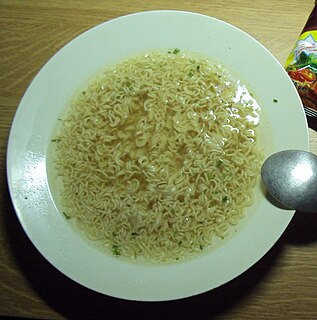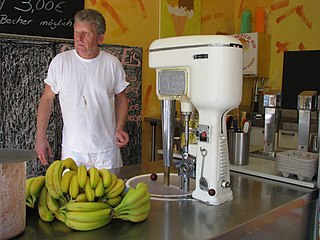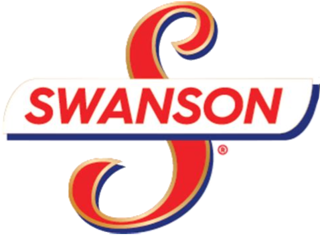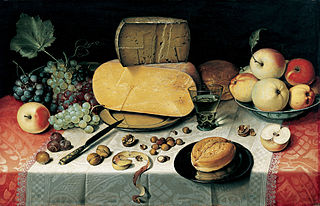
Food storage is a way of decreasing the variability of the food supply in the face of natural, inevitable variability. It allows food to be eaten for some time after harvest rather than solely immediately. It is both a traditional domestic skill and, in the form of food logistics, an important industrial and commercial activity. Food preservation, storage, and transport, including timely delivery to consumers, are important to food security, especially for the majority of people throughout the world who rely on others to produce their food.

The product known as Kraft Dinner (KD) in Canada, Kraft Macaroni & Cheese in the United States and Australia, and Macaroni Cheese in the United Kingdom is a nonperishable, packaged dry macaroni product by Kraft Foods Group, traditionally cardboard-boxed with dried macaroni pasta and a packet of processed cheese powder. It was first introduced under the Kraft Dinner name simultaneously in both Canada and the U.S. in 1937. The brand is popular with Canadians, who consume 55% more boxes per capita than Americans.

Freezing food preserves it from the time it is prepared to the time it is eaten. Since early times, farmers, fishermen, and trappers have preserved grains and produce in unheated buildings during the winter season. Freezing food slows decomposition by turning residual moisture into ice, inhibiting the growth of most bacterial species. In the food commodity industry, there are two processes: mechanical and cryogenic. The freezing kinetics is important to preserve the food quality and texture. Quicker freezing generates smaller ice crystals and maintains cellular structure. Cryogenic freezing is the quickest freezing technology available due to the ultra low liquid nitrogen temperature −196 °C (−320 °F).

Convenience food, also called tertiary processed food, is food that is commercially prepared to optimise ease of consumption. Such food is usually ready to eat without further preparation. It may also be easily portable, have a long shelf life, or offer a combination of such convenient traits. Although restaurant meals meet this definition, the term is seldom applied to them. Convenience foods include ready-to-eat dry products, frozen foods such as TV dinners, shelf-stable foods, prepared mixes such as cake mix, and snack foods.

A frozen meal, prepackaged meal, ready-made meal, ready meal (UK), frozen dinner, and microwave meal) is a packaged frozen meal that comes portioned for an individual. A frozen meal in the United States and Canada usually consists of a type of meat for the main course, and sometimes vegetables, potatoes, and/or a dessert. The main dish can also be pasta or fish. In European frozen meals, Indian and Chinese meals are common. Another form of convenience food, which is merely a refrigerated ready meal that requires less heating but expires sooner, is popular in the UK.

Scrambled eggs are a dish made from eggs stirred, whipped or beaten together while being gently heated, typically with salt, butter, oil and sometimes other ingredients.

A baked potato, known in some parts of the United Kingdom as a jacket potato, is a preparation of potato. The ideal baked potato has a fluffy interior and a crispy skin. It may be served with fillings, toppings or condiments such as butter, cheese, sour cream, gravy, baked beans, and even ground meat or corned beef.
Snap freezing is the process of rapid cooling of a substance for the purpose of preservation. It is widely used in the culinary and scientific industries.

A domestic ice cream maker is a machine used to make small quantities of ice cream for personal consumption. Ice cream makers may prepare the mixture by employing the hand-cranking method or by employing an electric motor. The resulting preparation is often chilled through either pre-cooling the machine or by employing a machine which freezes the mixture.

Swanson is a brand of TV dinners, broths, and canned poultry made for the North American and Hong Kong markets. The former "Swanson Company" was founded in Omaha, Nebraska, where it developed improvements of the frozen dinner. The TV dinner business is currently owned by Conagra Brands, while the broth business is currently owned by the Campbell Soup Company. TV dinner products currently sold under the brand include Swanson's Classics TV dinners and pot pies, and the current broth lineup includes chicken broth and beef broth.
Dream Dinners is a US food preparation franchise operation based in Snohomish, Washington. It specializes in providing space to prepare meals ahead of time for freezing and cooking at home. There are currently 105 locations in 30 states. The company was founded by Stephanie Allen and Tina Kuna and was the first in the category of "Meal Assembly" franchises.
Super Suppers was a US food preparation franchise operation based in Fort Worth, Texas. It specialized in providing space for families to prepare meals ahead of time for freezing and cooking at home. Once at 165 stores, the franchise ceased operations in 2011; currently six independently owned stores exist and are entitled to use the Super Suppers name and visual branding.

Chicken is the most common type of poultry in the world. Owing to the relative ease and low cost of raising chickens—in comparison to mammals such as cattle or hogs—chicken meat and chicken eggs have become prevalent in numerous cuisines.

Chicken and dumplings is a soup that consists of a chicken cooked in water, with the resulting chicken broth being used to cook the dumplings by boiling. A dumpling—in this context—is a biscuit dough, which is a mixture of flour, shortening, and liquid. The dumplings are either rolled out flat, dropped, or formed into a ball.

Prison food is the term for meals served to prisoners while incarcerated in correctional institutions. While some prisons prepare their own food, many use staff from on-site catering companies. Some prisons support the dietary requirements of specific religions, as well as vegetarianism. Prisoners will typically receive a series of standard meals per day from the prison, but in many prisons they can supplement their diets by purchasing additional foods, including snacks and desserts, at the prison commissary with money earned from working in the prison or sent by family and friends.

Meal preparation, sometimes called meal prep, is the process of planning and preparing meals.

Retail food delivery is a courier service in which a restaurant, store, or independent food-delivery company delivers food to a customer. An order is typically made either through a restaurant or grocer's website or mobile app, or through a food ordering company. The delivered items can include entrees, sides, drinks, desserts, or grocery items and are typically delivered in boxes or bags. The delivery person will normally drive a car, but in bigger cities where homes and restaurants are closer together, they may use bikes or motorized scooters. Recently, autonomous vehicles have also been used to complete deliveries.

A meal is an eating occasion that takes place at a certain time and includes prepared food. The names used for specific meals in English vary, depending on the speaker's culture, the time of day, or the size of the meal.

A meal kit is a subscription service–foodservice business model where a company sends customers pre-portioned and sometimes partially-prepared food ingredients and recipes to prepare homecooked meals. Services that send pre-cooked meals are called meal delivery services. This subscription model has been cited as an example of the personalization of the food and beverage industry that is becoming more popular and widespread.















